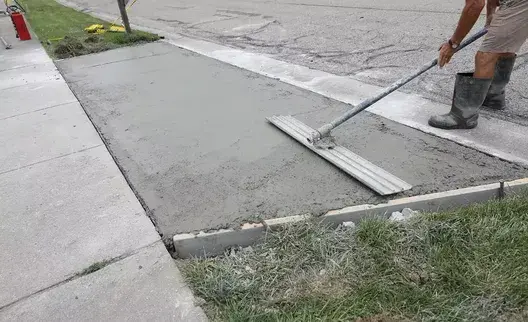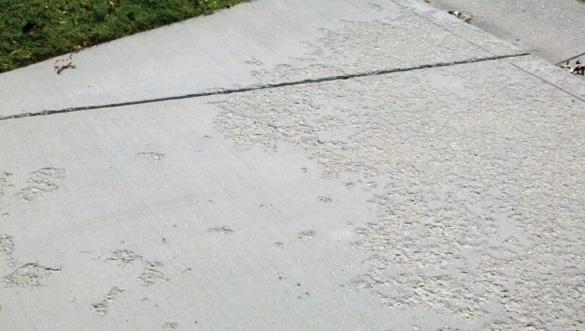Cared and paved sidewalks are not just about beauty. They contribute to the safety of the urban space, save from expensive legal issues and increase value. However, these benefits are subjected to be turned into drawbacks. These drawbacks are associated with the concrete structures as the structure wears out. They may develop areas that are potential dangers to people. This guide fixing sidewalk concrete is beneficial to every person. No matter if you’re a homeowner keen on maintaining your house and territory’s cleanliness or an individual who decided to take up a sidewalk job, or a professional.
After reading this article, you will have every ability to repair or maintain sidewalks on your own. You will also be able to make a wiser decision when hiring professionals such as Hi Tech Construction NY.

Identifying Sidewalk Damage
Before fixing sidewalk concrete, one needs to assess the damage to decide what kind of repair service is needed. Sidewalk concrete bears a direct impact especially on people walking on it. At the same time, the worst weather elements are shifting ground below it.
Common Signs of Concrete Damage to Watch For
Cracks or Chips
They may seem minor but can create damage in the future if not addressed properly.
Uneven Surfaces
These are due to the earth surface sinking or growing trees forming obstacles that one can easily trip on.
Spalling
It flacks or peals to expose the bare face. Especially through the effect of water in the process. Freezing and thawing cycles or use of wrong chemicals, usually the de-icing can make it worse.
Sunken Sections
They are established where the ground upon which the sidewalk is established washes away or becomes compact.
The Impact of Weather and Soil Conditions
Relative Humidity: It can enlarge cracks as the moisture content in the air moistens the cracks. Expansion of the frozen rain water when it freezes on the crack surfaces can also swell the cracks.
Heavy Rainfall: With time, this exposes sections of the structure on bare ground. Soil erosion is likely to cause parts of the concrete to decompose.
Tree roots: As time goes by, tree roots will pull concrete slabs up from below the ground’s surface.
When these aspects are clear. You will have the clarity that you require to proceed to correct them.
Preparing for the Repair Process
If there is one thing that can define the outcome of any project. It is what has been arranged before the actual project. Good repairs involve having the right equipment and appropriate materials as well as respecting safety measures.
Tools and Materials Needed:
Concrete mix or patching compounds
A mixing bucket and trowel
Safety goggles and gloves
A concrete saw (for large sections requiring repair works)
Leveling tools and measuring tape
A broom for surface cleaning
Safety First:
Wear protective clothing to cover your eyes and hands as you take the necessary precautions when handling concrete. If you are going to use heavy instruments such as the saw, care is essential to follow the instructions provided in the production manuals. To minimize access of pedestrians and ensure their safety one should set up barriers to cover the area to be under repair.
DIY Repair vs. Professional Help

Ask yourself these points.
Estimate of skill: Are you sure that you are ready to take the project and deal with it on your own without any doubts?
Extent of Damage: Smaller cracks are something that can be easily fixed by the homeowner on their own. Large portions which may include slabs or possible leveling might require a professional to do it.
In such cases, or where time is important, consider seeking the services of professionals such as Hi Tech Construction NY. We deal with fixing sidewalk concrete services in New York.
Step-by-Step Guide to Fixing Sidewalk Concrete
Patching up a sidewalk made of concrete might seem very complicated. But it is very easy when followed by following these steps. Here’s a clear breakdown.
1. Assess the Damage
Take a measure of crack width and length as well as depressed or sagging areas. Consequently, if you find that you have more than 1 inch deep cracks and if you find large uneven slabs, additional work is needed.
2. Clear and Clean the Area
The first step is to sweep off any dirt and debris on the working surface with the aid of a broom. For cracks, try blowing compressed air with an idea of clearing all the fine dust trapped in the gaps. This is because a clean surface provides a better contact between the new concrete while fixing sidewalk concrete.
3. Mix the Concrete
Take the concrete as described above keeping in mind that it should not be too runny or too thick. One can use a wheelbarrow or a mixing bucket to ensure that the mix is well homogenized.
4. Apply the Concrete
Bad Cracks: In filling the crack, you should Use the patching compound and trowel. You should level it to the degree of flat as the floor of the neighbouring concrete.
For Uneven Slabs: To prevent this, one should opt for a self leveling concrete mix and apply it over the area evenly.
For Entire Sections: In case of the whole sections of the slabs that are damaged. The damaged part has to be cut off using a concrete saw. Then it is replaced with fresh concrete and leveled appropriately.
5. Smooth and Finish
To enhance and achieve a perfect flat surface, apply a trowel on the surface. The surface should be lightly brushed to create a non-slip texture after each application before it dries up.
6. Allow it to Set
It is also important that users should always check the label for the time required to cure the concrete mix. It is suggested not to come into contact with the repaired section until the specific area is dry and hardened.
Tips for Preventative Maintenance
Nothing is more important than ensuring that this part is protected rather than fixed when it is damaged. This is especially true in the case of fixing sidewalk concrete.
Seal Your Concrete: You should seal your concrete block at least once a year to prevent penetration of moisture and breakage due to the effects of UV radiation.
Trim Nearby Plants: The tree’s roots should not be left uncontrolled nearby plants.
Choose the Right De-Icers: The materials used in these melt the ice and snow should not harm the concrete wardrobes. Use friendly chemicals such as calcium chloride instead of glycol.
Maintenance: A simple walk up should be taken occasionally to notice any crack defects on the wall every few months.
Following these steps will increase the sidewalk’s durability and use as well as the beauty and functionality it offers the world.
Difference in DIY repair and professional repair and its costs.
The first question that will and need to be answered is whether to do it yourself or to hire a professional? Here’s a quick cost breakdown:
DIY Repairs
Materials (Concrete mix, tools): $50–$200
Time Taken: This will take only a few hours up to a full day depending on the size of the repair.
Professional Repairs
Factors to Consider:
The ordinary individuals provide a professional, high-quality finish to the work done.
Duration vs. Expenses: Considering the time factor, you can end up saving much more by hiring an expert.
If you are in any need of excellent repair services in New York. You should try Hi Tech Construction NY.
Maintain Safe and Beautiful Sidewalks
Fixing sidewalk concrete is not just about increasing the elegance of your property. It also guards people using the pavement and prevents legal actions. If you choose to do it alone, or seek help from a professional, the outlined procedures will help you in achieving a good and secure long-term repair.
In case you are still in doubt or for the most exceptional outcome. Hi Tech Construction NY is here for you! For more specific information, website design quotations and consultancy, please get in touch with us. As a result, your perfect sidewalk is just a call away.
To avial our services, Please visit our service page
or
